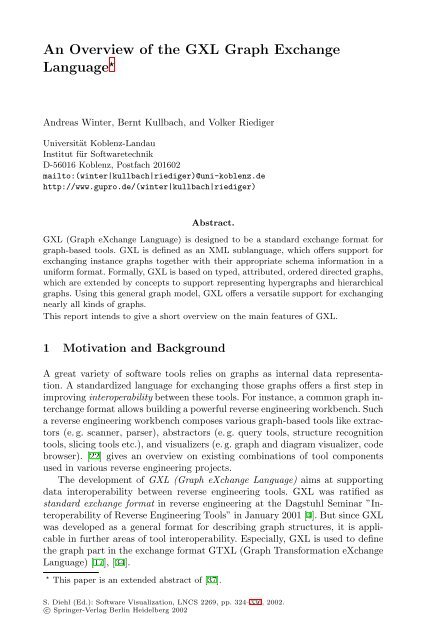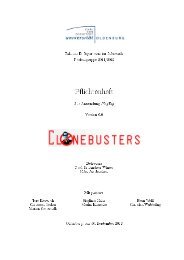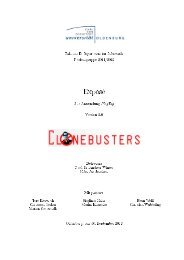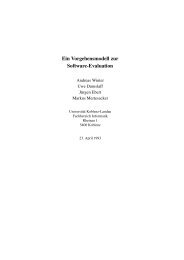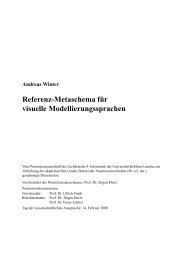An Overview of the GXL Graph Exchange Language* - Se.uni ...
An Overview of the GXL Graph Exchange Language* - Se.uni ...
An Overview of the GXL Graph Exchange Language* - Se.uni ...
Create successful ePaper yourself
Turn your PDF publications into a flip-book with our unique Google optimized e-Paper software.
<strong>An</strong> <strong>Overview</strong> <strong>of</strong> <strong>the</strong> <strong>GXL</strong> <strong>Graph</strong> <strong>Exchange</strong><br />
Language ⋆<br />
<strong>An</strong>dreas Winter, Bernt Kullbach, and Volker Riediger<br />
Universität Koblenz-Landau<br />
Institut für S<strong>of</strong>twaretechnik<br />
D-56016 Koblenz,Postfach 201602<br />
mailto:(winter|kullbach|riediger)@<strong>uni</strong>-koblenz.de<br />
http://www.gupro.de/(winter|kullbach|riediger)<br />
Abstract.<br />
<strong>GXL</strong> (<strong>Graph</strong> eXchange Language) is designed to be a standard exchange format for<br />
graph-based tools. <strong>GXL</strong> is defined as an XML sublanguage,which <strong>of</strong>fers support for<br />
exchanging instance graphs toge<strong>the</strong>r with <strong>the</strong>ir appropriate schema information in a<br />
<strong>uni</strong>form format. Formally,<strong>GXL</strong> is based on typed,attributed,ordered directed graphs,<br />
which are extended by concepts to support representing hypergraphs and hierarchical<br />
graphs. Using this general graph model,<strong>GXL</strong> <strong>of</strong>fers a versatile support for exchanging<br />
nearly all kinds <strong>of</strong> graphs.<br />
This report intends to give a short overview on <strong>the</strong> main features <strong>of</strong> <strong>GXL</strong>.<br />
1 Motivation and Background<br />
A great variety <strong>of</strong> s<strong>of</strong>tware tools relies on graphs as internal data representation.<br />
A standardized language for exchanging those graphs <strong>of</strong>fers a first step in<br />
improving interoperability between <strong>the</strong>se tools. For instance, a common graph interchange<br />
format allows building a powerful reverse engineering workbench. Such<br />
a reverse engineering workbench composes various graph-based tools like extractors<br />
(e. g. scanner, parser), abstractors (e. g. query tools, structure recognition<br />
tools, slicing tools etc.), and visualizers (e. g. graph and diagram visualizer, code<br />
browser). [22] gives an overview on existing combinations <strong>of</strong> tool components<br />
used in various reverse engineering projects.<br />
The development <strong>of</strong> <strong>GXL</strong> (<strong>Graph</strong> eXchange Language) aims at supporting<br />
data interoperability between reverse engineering tools. <strong>GXL</strong> was ratified as<br />
standard exchange format in reverse engineering at <strong>the</strong> Dagstuhl <strong>Se</strong>minar ”Interoperability<br />
<strong>of</strong> Reverse Engineering Tools” in January 2001 [4]. But since <strong>GXL</strong><br />
was developed as a general format for describing graph structures, it is applicable<br />
in fur<strong>the</strong>r areas <strong>of</strong> tool interoperability. Especially, <strong>GXL</strong> is used to define<br />
<strong>the</strong> graph part in <strong>the</strong> exchange format GTXL (<strong>Graph</strong> Transformation eXchange<br />
Language) [17], [34].<br />
⋆ This paper is an extended abstract <strong>of</strong> [37].<br />
S. Diehl (Ed.): S<strong>of</strong>tware Visualization, LNCS 2269, pp. 324–336, 2002.<br />
c○ Springer-Verlag Berlin Heidelberg 2002
<strong>An</strong> <strong>Overview</strong> <strong>of</strong> <strong>the</strong> <strong>GXL</strong> <strong>Graph</strong> <strong>Exchange</strong> Language 325<br />
<strong>GXL</strong> originated in a merger <strong>of</strong> GRAph eXchange format (GraX) [7], Tuple<br />
Attribute Language (TA) [21], and <strong>the</strong> graph format <strong>of</strong> <strong>the</strong> PROGRES graph<br />
rewriting system [32]. The graph models used here were supplemented by additional<br />
concepts to handle hierarchical graphs and hypergraphs. Fur<strong>the</strong>rmore,<br />
<strong>GXL</strong> includes ideas from common exchange formats used in reverse engineering,<br />
including Relation Partition Algebra (RPA) [27] and Rigi Standard Format<br />
(RSF) [38]. The development <strong>of</strong> <strong>GXL</strong> was also influenced by various formats<br />
used in graph drawing, e. g. daVinci [10], GML [16], XGMML (eXtensible <strong>Graph</strong><br />
Markup and Modeling Language) [39], and <strong>Graph</strong>XML [20]. Thus, <strong>GXL</strong> covers<br />
most <strong>of</strong> <strong>the</strong> important graph formats. <strong>GXL</strong> can be viewed as a generalization <strong>of</strong><br />
<strong>the</strong>se formats.<br />
Exchanging graphs with <strong>GXL</strong> deals with both instance graphs and <strong>the</strong>ir corresponding<br />
graph schemas. Firstly, <strong>GXL</strong> <strong>of</strong>fers a versatile support for exchanging<br />
all kinds <strong>of</strong> graphs based on typed, attributed, directed, ordered graphs including<br />
hypergraphs and hierarchical graphs. <strong>Se</strong>condly, <strong>GXL</strong> <strong>of</strong>fers means for exchanging<br />
graph schemas representing <strong>the</strong> graph structure, i. e. <strong>the</strong> definition <strong>of</strong> node and<br />
edge types, <strong>the</strong>ir attribute schemas and <strong>the</strong>ir incidence structure. Both, instance<br />
graphs and graph schemas, are exchanged by XML documents (Extended Markup<br />
Language) [35].<br />
This paper introduces into <strong>the</strong> basic concepts <strong>of</strong> <strong>GXL</strong> version 1.0 for exchanging<br />
instance graphs (cf. section 2) and graph schemas (cf. section 3). The language<br />
definition <strong>of</strong> <strong>GXL</strong> is given by its XML document type definition (DTD).<br />
<strong>Se</strong>ction 4 summarizes <strong>the</strong> current usage <strong>of</strong> <strong>GXL</strong>.<br />
A more comprehensive description <strong>of</strong> <strong>GXL</strong> is given in [37]. Up-to-date information<br />
including tutorials and fur<strong>the</strong>r <strong>GXL</strong> documents are collected at http:<br />
//www.gupro.de/<strong>GXL</strong>.<br />
2 Exchanging <strong>Graph</strong>s<br />
Due to <strong>the</strong>ir ma<strong>the</strong>matical foundation and algorithmic power, graphs are a common<br />
data structure in s<strong>of</strong>tware engineering. Different graph models, e. g. directed<br />
graphs, undirected graphs, node attributed graphs, edge attributed graphs,<br />
node typed graphs, edge typed graphs, ordered graphs, relational graphs, acyclic<br />
graphs, trees, etc. or combinations <strong>of</strong> <strong>the</strong>se graph models are utilized in many<br />
s<strong>of</strong>tware systems. To support interoperability <strong>of</strong> graph based tools, <strong>the</strong> underlying<br />
graph model has to be as rich as possible to cover most <strong>of</strong> <strong>the</strong>se graph<br />
models.<br />
Such a common graph model is given by typed, attributed, directed, ordered<br />
graphs (T<strong>Graph</strong>s) [6], [7]. T<strong>Graph</strong>s are directed graphs, whose nodes and edges<br />
may be attributed and typed. Each type can be assigned an individual attribute<br />
schema specifying <strong>the</strong> possible attributes <strong>of</strong> nodes and edges. Fur<strong>the</strong>rmore,<br />
T<strong>Graph</strong>s are ordered, i. e. <strong>the</strong> node set, <strong>the</strong> edge set, and <strong>the</strong> sets <strong>of</strong> edges incident<br />
to a node have a total ordering. This ordering gives modeling power to<br />
describe sequences <strong>of</strong> objects (e. g. parameter lists) and facilitates <strong>the</strong> implementation<br />
<strong>of</strong> deterministic graph algorithms. In applying T<strong>Graph</strong>s to <strong>the</strong> sketched
326 A. Winter,B. Kullbach,and V. Riediger<br />
graph models, not all properties <strong>of</strong> T<strong>Graph</strong>s have to be used to <strong>the</strong>ir full extent.<br />
These graph models can be viewed as specializations <strong>of</strong> T<strong>Graph</strong>s. Exchanging<br />
T<strong>Graph</strong>s with <strong>GXL</strong> is introduced in section 2.1<br />
To <strong>of</strong>fer support for hypergraphs and hierarchical graphs, T<strong>Graph</strong>s were extended<br />
by n-ary edges and by nodes and edges containing lower level graphs.<br />
<strong>GXL</strong> language constructs for exchanging those extended graphs are sketched in<br />
section 2.2. The complete <strong>GXL</strong> language definition in terms <strong>of</strong> an XML document<br />
type definition is given in section 2.3.<br />
2.1 Exchanging Typed, Attributed, Directed, Ordered <strong>Graph</strong>s<br />
The UML object diagram (cf. [31]) in figure 1 shows a node and edge typed, node<br />
and edge attributed, directed, ordered graph representing a program fragment on<br />
ASG (abstract syntaxgraph) level. Function main calls function a = max(a, b)<br />
in line 8 and function b = min(b, a) in line 19.<br />
v1 : Function<br />
e1 : isCaller<br />
line = 8<br />
name = "main"<br />
e2 : isCaller<br />
line = 19<br />
v2 : FunctionCall<br />
v3 : FunctionCall<br />
e3 : isCallee<br />
{1} {2} e6 : isInput<br />
{2}<br />
e7 : isInput<br />
{1}<br />
e4 : isCallee<br />
v4 : Function<br />
name = "max"<br />
e5: isInput e8 : isInput<br />
v5 : Function<br />
name = "min"<br />
e9 : isOutput<br />
e10 : isOutput<br />
v6 : Variable<br />
v7 : Variable<br />
name = "a"<br />
name = "b"<br />
Fig. 1. Typed,attributed,directed,ordered graph<br />
The functions main, max and min are represented by nodes <strong>of</strong> type Function.<br />
These nodes are attributed with <strong>the</strong> functions’ name. FunctionCall nodes<br />
represent <strong>the</strong> calls <strong>of</strong> functions max and min. FunctionCall nodes are associated<br />
to <strong>the</strong> caller by isCaller edges and to <strong>the</strong> callee by isCallee edges. isCaller edges<br />
are attributed with a line attribute showing <strong>the</strong> line number which contains <strong>the</strong><br />
call. Input parameters (represented by Variable nodes that are attributed with<br />
<strong>the</strong> variables’ name) are associated by isInput edges. The ordering <strong>of</strong> parameter<br />
lists is given by ordering <strong>the</strong> incidences <strong>of</strong> isInput edges pointing to FunctionCall<br />
nodes. The first edge <strong>of</strong> type isInput incident to function call v2 (modeling <strong>the</strong><br />
call <strong>of</strong> max(a,b)) comes from node v6 representing variable a. The second edge<br />
<strong>of</strong> type isInput connects to <strong>the</strong> second parameter b (node v7 ). The incidences
<strong>An</strong> <strong>Overview</strong> <strong>of</strong> <strong>the</strong> <strong>GXL</strong> <strong>Graph</strong> <strong>Exchange</strong> Language 327<br />
<strong>of</strong> isInput edges associated with node v3 model <strong>the</strong> reversed parameter order.<br />
Output parameters are associated to <strong>the</strong>ir function calls by isOutput edges.<br />
Exchanging graphs like <strong>the</strong> one in figure 1 requires language constructs for<br />
representing nodes, edges and <strong>the</strong>ir incidence relation. Fur<strong>the</strong>rmore, support for<br />
describing type information and attribute values is needed.<br />
<br />
<br />
<br />
<br />
<br />
<br />
<br />
<br />
main<br />
<br />
<br />
<br />
<br />
<br />
<br />
<br />
<br />
<br />
<br />
<br />
max<br />
<br />
<br />
<br />
<br />
<br />
min<br />
<br />
<br />
<br />
<br />
<br />
a<br />
<br />
<br />
<br />
<br />
<br />
b<br />
<br />
<br />
<br />
<br />
<br />
8<br />
<br />
<br />
<br />
<br />
<br />
19<br />
<br />
<br />
<br />
<br />
<br />
328 A. Winter,B. Kullbach,and V. Riediger<br />
ges including edge orientation is stored in from and to attributes within <br />
tags. Ordering <strong>of</strong> incidences is also modeled here. Attributes fromorder and toorder<br />
represent <strong>the</strong> position <strong>of</strong> an edge in <strong>the</strong> incidence list <strong>of</strong> its start and target<br />
node.<br />
Node and edge types are represented by links pointing to <strong>the</strong> appropriate<br />
schema information. These links are enclosed in elements.<br />
and elements may additionally contain fur<strong>the</strong>r attribute<br />
information. elements describe attribute names and values. Like OCL<br />
[36], <strong>GXL</strong> provides , , , and attributes. Fur<strong>the</strong>rmore,<br />
enumeration values () and URI-references () to externally<br />
stored objects are supported. Attribute values might be substructured.<br />
Here, <strong>GXL</strong> <strong>of</strong>fers composite attributes like sequences (), sets (),<br />
multi sets (), and tuples ().<br />
2.2 Exchanging Extended <strong>Graph</strong>s<br />
In addition to typed, attributed, ordered, directed graphs, <strong>GXL</strong> provides <strong>the</strong><br />
exchange <strong>of</strong> hypergraphs and hierarchical graphs.<br />
Hypergraphs contain n-ary edges (hyperedges) connecting not only two adjacent<br />
nodes. Hyperedges are exchanged by elements, containing references<br />
to <strong>the</strong> incident graph objects. These references (tentacles) are stored in <br />
elements (relation end).<br />
Edges can be viewed as 2-ary hyperedges. Thus, in <strong>GXL</strong>, edge information<br />
can be represented by binary hyperedges. Since graphs with (binary) edges are widespread<br />
in s<strong>of</strong>tware engineering and most applications deal with graphs instead<br />
<strong>of</strong> hypergraphs, <strong>GXL</strong> <strong>of</strong>fers both, <strong>the</strong> element for exchanging (binary)<br />
edges and and <strong>the</strong> element for hyperedges.<br />
Like binary edges, tentacles may be directed or undirected as well as ordered.<br />
The ordering <strong>of</strong> tentacles incident to <strong>the</strong>ir target object and <strong>the</strong> ordering <strong>of</strong><br />
tentacles with respect to <strong>the</strong>ir hyperedge object is represented analogously to<br />
<strong>the</strong> ordering <strong>of</strong> incident edges by using XML attributes.<br />
Hierarchical graphs are graphs where nodes, edges, and hyperedges contain<br />
fur<strong>the</strong>r graphs. <strong>GXL</strong> supports exchanging hierarchical graphs by nesting those<br />
inner graphs as elements in <strong>the</strong>ir enclosing node, edge, and hyperedge<br />
representation.<br />
2.3 <strong>GXL</strong> Document Type Definition<br />
The language features <strong>of</strong> <strong>GXL</strong> for exchanging typed, attributed, directed, ordered<br />
graphs (cf. section 2.1) and extended graphs (cf. section 2.2) are summarized<br />
in a conceptual model defining <strong>the</strong> graph model supported by <strong>GXL</strong>. The <strong>GXL</strong><br />
graph model is completely described at http://www.gupro.de/<strong>GXL</strong>/ (graph model)<br />
with its graph structure part and its attribute part.<br />
Since <strong>GXL</strong> is an XML sublanguage, <strong>the</strong> <strong>GXL</strong> graph model had to be transcribed<br />
into an XML document type definition (DTD) or an appropriate XML
<strong>An</strong> <strong>Overview</strong> <strong>of</strong> <strong>the</strong> <strong>GXL</strong> <strong>Graph</strong> <strong>Exchange</strong> Language 329<br />
schema definition. To keep <strong>GXL</strong> simple and less verbose, this translation was<br />
done by hand. The resulting DTD (cf. figure 3, a commented version is given<br />
at http://www.gupro.de/<strong>GXL</strong> (DTD)) requires only 18 XML elements. In contrast,<br />
an appropriate DTD generated with IBMs XMI Toolkit [23] according<br />
<strong>the</strong> XML Metadata Interchange (XMI) principles for developing DTDs [26, section<br />
3] requires 66 elements for <strong>the</strong> <strong>GXL</strong> core and and additional 63 elements<br />
for XMI and Corba related aspects.<br />
<br />
<br />
<br />
<br />
<br />
<br />
<br />
<br />
<br />
<br />
<br />
<br />
<br />
<br />
<br />
<br />
<br />
<br />
<br />
<br />
<br />
<br />
<br />
<br />
<br />
<br />
<br />
<br />
<br />
<br />
<br />
<br />
<br />
<br />
<br />
<br />
<br />
<br />
<br />
<br />
<br />
<br />
<br />
<br />
<br />
<br />
<br />
<br />
<br />
<br />
<br />
<br />
<br />
Fig. 3. <strong>GXL</strong> Document Type Definition
330 A. Winter,B. Kullbach,and V. Riediger<br />
3 Exchanging <strong>Graph</strong> Schemas<br />
<strong>Graph</strong>s only <strong>of</strong>fer a plain structured means for describing objects (nodes) and<br />
<strong>the</strong>ir interrelationship (edges, hyperedges). <strong>Graph</strong>s have no meaning <strong>of</strong> <strong>the</strong>ir<br />
own. The meaning <strong>of</strong> graphs corresponds to <strong>the</strong> context in which <strong>the</strong>y are used<br />
and exchanged. The application and interchange context determines<br />
– which node, edge, and hyperedge types are used,<br />
– how nodes, edges, and hyperedges <strong>of</strong> given types are related,<br />
– which attribute structures are associated to nodes, edges, and hyperedges,<br />
and<br />
– which additional constraints (like ordering <strong>of</strong> incidences, degree-restrictions<br />
etc.) have to be complied.<br />
This schematic data can be described by conceptual modeling techniques. Class<br />
diagrams <strong>of</strong>fer a suited declarative language to define graph classes with respect<br />
to a given application or interchange context [7].<br />
3.1 Describing <strong>Graph</strong> Classes by UML Class Diagrams<br />
In <strong>GXL</strong>, graph classes are defined by UML class diagrams [31]. Figure 4 shows<br />
a graph schema defining classes <strong>of</strong> graphs like <strong>the</strong> one given in figure 1. Node<br />
classes (FunctionCall, Function, and Variable) are defined by classes. Edge classes<br />
(isCallee, isInput, and isOutput) are defined by associations. Attributed edge<br />
classes (isCaller) are described by association classes. Like classes, <strong>the</strong>y contain<br />
<strong>the</strong> associated attribute structures. The orientation <strong>of</strong> edges is depicted by a<br />
filled triangle (cf. [31, p. 155]. Multiplicities denote degree restrictions. Ordering<br />
<strong>of</strong> incidences is indicated by <strong>the</strong> keyword {ordered}.<br />
1<br />
isCallee<br />
0 ..*<br />
FunctionCall<br />
0 ..*<br />
0 ..*<br />
{ordered}<br />
0 ..*<br />
isInput<br />
isOutput<br />
0 ..* 1<br />
Function<br />
name : string<br />
1 isCaller<br />
isCaller<br />
line : int<br />
Variable<br />
name : string<br />
Fig. 4. <strong>Graph</strong> schema (UML class diagram)<br />
In a similar way, UML class diagrams <strong>of</strong>fer language constructs to model<br />
classes <strong>of</strong> hyperedges (diamonds) and classes <strong>of</strong> attributed hyperedges (diamonds<br />
with an associated class). The definition <strong>of</strong> hierarchical graphs requires an additional<br />
language construct representing graph classes <strong>the</strong>mselves. This is done<br />
by stereotypes.<br />
To <strong>of</strong>fer up-to-date conceptual modeling power, <strong>the</strong> <strong>GXL</strong> schema notation<br />
provides generalization <strong>of</strong> node-, edge-, and hyperedge classes as well as aggregation<br />
and composition by using <strong>the</strong> appropriate UML notation.
<strong>An</strong> <strong>Overview</strong> <strong>of</strong> <strong>the</strong> <strong>GXL</strong> <strong>Graph</strong> <strong>Exchange</strong> Language 331<br />
3.2 Describing <strong>Graph</strong> Classes by <strong>Graph</strong>s<br />
Since UML class diagrams are structured information <strong>the</strong>mselves, <strong>the</strong>y may be<br />
represented as graphs as well. For exchanging graph schemas in <strong>GXL</strong>, UML class<br />
diagrams are transfered into equivalent graph representations. Thus, instance<br />
graphs and schemas are exchanged with <strong>the</strong> same type <strong>of</strong> document, i.e.XML<br />
documents matching <strong>the</strong> <strong>GXL</strong> DTD (cf. section 2.3).<br />
In contrast to <strong>the</strong> strategy proposed by XML Meta Data Interchange (XMI)<br />
[26], <strong>GXL</strong> schemas are not exchanged by XML documents according to <strong>the</strong><br />
Meta Object Facility (MOF) [25]. XMI/MOF <strong>of</strong>fers a general, but very verbose<br />
format for exchanging UML class diagrams as XML streams. By generating individual<br />
document type definitions to a given UML class diagram, it also supports<br />
exchanging instance graphs as XML documents. Next to its exaggerated verbosity,<br />
which contradicts <strong>the</strong> requirement for exchange formats <strong>of</strong> as compact as<br />
possible documents, <strong>the</strong> XMI/MOF approach requires different types <strong>of</strong> documents<br />
for representing schema and instance graphs. Especially in applications<br />
dealing with schema information on instance level (e. g. in tools for editing and<br />
analyzing schemas), this leads to <strong>the</strong> disadvantage <strong>of</strong> different documents representing<br />
<strong>the</strong> same information, one on instance level (as XML document) and one<br />
on schema level (as XML DTD). The <strong>GXL</strong> approach treats schema and instance<br />
information in exactly <strong>the</strong> same way. Schema and instance graphs are exchanged<br />
according to <strong>the</strong> DTD given in Figure 3.<br />
schema: <strong>Graph</strong>Class<br />
name = "Schema"<br />
contains<br />
FunctionCall :<br />
NodeClass<br />
name = "FunctionCall"<br />
isAbstract = false<br />
e1 : to<br />
limits = (0,-1)<br />
isOrdered = false<br />
e3 : to<br />
limits = (0,-1)<br />
isOrdered = false<br />
e5 : to<br />
limits = (0,-1)<br />
isOrdered = true<br />
e11 : to<br />
limits = (0,-1)<br />
isOrdered = false<br />
isCallee :<br />
EdgeClass<br />
name = "isCallee"<br />
isAbstract = false<br />
isDirected = true<br />
isCaller :<br />
EdgeClass<br />
name = "isCaller"<br />
isAbstract = false<br />
isDirected = true<br />
isInput :<br />
EdgeClass<br />
name = "isInput"<br />
isAbstract = false<br />
isDirected = true<br />
isOutput :<br />
EdgeClass<br />
name = "isOutput"<br />
isAbstract = false<br />
isDirected = true<br />
e7 : hasAttribute<br />
e2 : from<br />
limits = (1,1)<br />
isOrdered = false<br />
v7: AttributeClass<br />
name = "line"<br />
e8 : hasDomain<br />
e6 : from<br />
limits = (0,-1)<br />
isOrdered = false<br />
e12 : from<br />
limits = (1,1)<br />
isOrdered = false<br />
Function :<br />
NodeClass<br />
name = "Function"<br />
isAbstract = false<br />
e4 : from<br />
limits = (1,1)<br />
isOrdered = false<br />
v9 : Int<br />
v10 : String<br />
e11 : hasDomain<br />
Variable :<br />
NodeClass<br />
name = "Variable"<br />
isAbstract = false<br />
e9 : hasAttribute<br />
v8: AttributeClass<br />
name = "name"<br />
e10 : hasAttribute<br />
Fig. 5. <strong>Graph</strong> schema (schema graph)
332 A. Winter,B. Kullbach,and V. Riediger<br />
Figure 5 depicts <strong>the</strong> transformation <strong>of</strong> <strong>the</strong> class diagram in figure 4 into a<br />
node and edge typed, node and edge attributed, directed graph. Node classes,<br />
edge classes, attributes and <strong>the</strong>ir domains are modeled by nodes <strong>of</strong> suitable<br />
node types. Their attributes describe fur<strong>the</strong>r properties. Interrelationships between<br />
surrogates <strong>of</strong> <strong>the</strong>se classes are represented by edges <strong>of</strong> proper types. Attribute<br />
information is associated with surrogates <strong>of</strong> node classes, edge classes and<br />
associations by hasAttribute and hasDomain edges. from and to edges model incidences<br />
<strong>of</strong> associations including <strong>the</strong>ir orientation. Multiplicities <strong>of</strong> associations<br />
are stored in limits-attributes. The boolean attribute isOrdered indicates ordered<br />
incidences.<br />
Fur<strong>the</strong>r attribute types and extended concepts like graph hierarchy, classes <strong>of</strong><br />
hyperedges, aggregation and composition, generalization and default attribute<br />
values are modeled analogously.<br />
<strong>GXL</strong> documents, representing instance graphs <strong>of</strong> a given graph schema refer<br />
to those nodes <strong>of</strong> <strong>the</strong> equivalent schema graph representing node classes<br />
(NodeClass) and edge classes (EdgeClass). The graph class itself is represented<br />
by a <strong>Graph</strong>Class node. This node is connected by contains edges to all surrogates<br />
<strong>of</strong> node and edge classes defined in this graph class. Schema references<br />
in <strong>GXL</strong>-documents refer to <strong>the</strong>se <strong>Graph</strong>Class nodes in <strong>GXL</strong> schema graphs (cf.<br />
<strong>the</strong> type element <strong>of</strong> graph simple<strong>Graph</strong> in figure 2). In figure 5 nodes representing<br />
<strong>the</strong>se class definitions are shaded. These items are refered to by <strong>the</strong> instance<br />
graph in figure 1.<br />
<strong>GXL</strong> views edges as first class objects which have <strong>the</strong>ir own identity, might be<br />
typed and attributed, and might be included in a generalization hierarchy. Thus,<br />
surrogates <strong>of</strong> associations and associated classes have to be connected to fur<strong>the</strong>r<br />
information. For generality and simplicity reasons <strong>GXL</strong> schema graphs are<br />
restricted to ordinary typed, attributed, directed graphs. Hence, this edge-like<br />
information is represented by nodes as well. Although <strong>the</strong> <strong>GXL</strong> DTD provides<br />
edges connecting edges, <strong>GXL</strong> schema graphs do not use this feature.<br />
The graph class <strong>of</strong> correct <strong>GXL</strong> schema graphs is represented as a <strong>GXL</strong><br />
schema. A UML diagram representing this <strong>GXL</strong> metaschema is presented with its<br />
graph part, its attribute part, and its value part at http://www.gupro.de/<strong>GXL</strong>/<br />
(meta schema).<br />
Each UML class diagram defining a <strong>GXL</strong> graph schema can be represented by<br />
a graph (schema graph) matching <strong>the</strong> <strong>GXL</strong> metaschema. Thus, schema graphs<br />
are instances <strong>of</strong> <strong>the</strong> <strong>GXL</strong> metaschema. They are exchanged like all instance<br />
graphs (cf. section 2) referring to a <strong>GXL</strong> document, here representing <strong>the</strong> <strong>GXL</strong><br />
metaschema. Since <strong>the</strong> schema graph representing <strong>the</strong> <strong>GXL</strong> metaschema is an<br />
instance <strong>of</strong> itself, it is exchanged by a self referring <strong>GXL</strong> document.<br />
4 Using <strong>GXL</strong><br />
At <strong>the</strong> Dagstuhl seminar on ”Interoperability <strong>of</strong> Reverse Engineering Tools”<br />
<strong>GXL</strong> version 1.0 was ratified as <strong>the</strong> standard exchange format in reverse engineering<br />
[4]. Currently, various groups in s<strong>of</strong>tware (re)engineering are implementing
<strong>An</strong> <strong>Overview</strong> <strong>of</strong> <strong>the</strong> <strong>GXL</strong> <strong>Graph</strong> <strong>Exchange</strong> Language 333<br />
<strong>GXL</strong> import and export facilities to <strong>the</strong>ir tools (e. g. Bauhaus [1], Columbus [8],<br />
CPPX [3], Fujaba [11], GUPRO [18], PBS [28], RPA (Philips Research), PROG-<br />
RES [29], Rigi [30], Shrimp [33]). O<strong>the</strong>rs are going to implement tools to support<br />
working with <strong>GXL</strong>. For instance, a framework for <strong>GXL</strong> Converters [12] and an<br />
XMI2<strong>GXL</strong> translator [40] were developed at Univ. BW München. Fur<strong>the</strong>r activities<br />
deal with providing graph query machines (GReQL, Univ. Koblenz) to<br />
<strong>GXL</strong> graphs or <strong>GXL</strong>-based graph databases (Univ. Aachen).<br />
<strong>An</strong> important feature <strong>of</strong> <strong>GXL</strong> is its support for exchanging schema information.<br />
Based on this capability, reference schemas for certain standard applications<br />
in reverse engineering are currently under development. These activities address<br />
reference schemas for data reverse engineering (DRE, Univ. Namur, Paderborn,<br />
Victoria), <strong>the</strong> Dagstuhl Middle Model [24] or abstract syntaxgraph models for<br />
C++ [3], [9].<br />
Fur<strong>the</strong>rmore, groups developing graph transformation tools (e. g. Gen<strong>Se</strong>t [15],<br />
PROGRES [29]) or graph visualization tools (e. g. GVF [19], Shrimp [33], yFiles<br />
[41]) already use <strong>GXL</strong> or pronounced to use <strong>GXL</strong>. At University <strong>of</strong> Toronto,<br />
<strong>GXL</strong> is applied within an undergraduate s<strong>of</strong>tware engineering course to create<br />
a graph editor/layouter [5].<br />
<strong>GXL</strong> also serves as foundation to define fur<strong>the</strong>r graph oriented exchange formats.<br />
Thus, <strong>GXL</strong> defines <strong>the</strong> graph part in <strong>the</strong> exchange format GTXL (<strong>Graph</strong><br />
Transformation eXchange Language) [17], [34]. Activities in <strong>the</strong> graph drawing<br />
comm<strong>uni</strong>ty also deal with <strong>the</strong> development <strong>of</strong> an exchange format for graph<br />
layout [13]. In a panel on graph exchange formats at <strong>Graph</strong> Drawing 2001 in<br />
Vienna [14] <strong>GXL</strong> and <strong>Graph</strong>ML [2] were discussed and compared. There is evidence<br />
<strong>of</strong> combining <strong>the</strong> structure part <strong>of</strong> <strong>GXL</strong> with <strong>the</strong> graph layout part and<br />
<strong>the</strong> modularization part <strong>of</strong> <strong>Graph</strong>ML to form a general and comprehensive graph<br />
exchange format.<br />
5 Conclusion<br />
The previous sections gave a short introduction in <strong>the</strong> <strong>GXL</strong> <strong>Graph</strong> eXchange<br />
Language version 1.0 and its current applications.<br />
Summarizing, <strong>GXL</strong> <strong>of</strong>fers an already widely used XML sublanguage for interchanging<br />
typed, attributed, directed ordered graphs including hypergraphs and<br />
hierarchical graphs including <strong>the</strong>ir appropriate schemas. By focusing on graph<br />
structure, <strong>GXL</strong> provides <strong>the</strong> core for defining a family <strong>of</strong> special suited graph<br />
exchange formats.<br />
Acknowledgment. We would like to thank <strong>the</strong> <strong>GXL</strong> co-authors Richard C.<br />
Holt, <strong>An</strong>dy Schürr, and Susan Sim for various fruitful discussions on <strong>the</strong> development<br />
<strong>of</strong> <strong>GXL</strong>, and Oliver Heinen and Kevin Hirschmann for realizing <strong>the</strong><br />
<strong>GXL</strong> web-site and for implementing <strong>the</strong> GUPRO related <strong>GXL</strong> tools. Thanks<br />
to Rainer Koschke for many interesting discussions on interchange formats in<br />
reverse engineering, and some helpful remarks to improve this paper. Thanks to
334 A. Winter,B. Kullbach,and V. Riediger<br />
all <strong>the</strong> users <strong>of</strong> <strong>GXL</strong>, who currently applying and testing <strong>GXL</strong> 1.0 in <strong>the</strong>ir tools.<br />
Their experience will be a significant aid to improve <strong>GXL</strong>.<br />
References<br />
1. Bauhaus: S<strong>of</strong>tware Architecture,S<strong>of</strong>tware Reengineering,and Program Understanding.<br />
http://www.informatik.<strong>uni</strong>-stuttgart.de/ifi/ps/bauhaus/<br />
(01.09.2001).<br />
2. U. Brandes,M. Eiglsperger,I. Herman,M. Himsolt,and M. S. Marschall. <strong>Graph</strong>ML<br />
Progress Report,Structural Layer Proposal. In to appear: <strong>Graph</strong> Drawing 2001<br />
(Proceedings). 2001.<br />
3. CPPX: Open Source C++ Fact Extractor.<br />
http://swag.uwaterloo.ca/˜cppx/ (01.09.2001).<br />
4. J. Ebert,K. Kontogiannis,J. Mylopoulos: Interoperability <strong>of</strong> Reverse Engineering<br />
Tools. http://www.dagstuhl.de/DATA/Reports/01041/ (18.04.2001),2001.<br />
5. S. Easterbrook. CSC444F: S<strong>of</strong>tware Engineering I (Fall Term 2001),University <strong>of</strong><br />
Toronto. http://www.cs.toronto.edu/˜sme/CSC444F/ (15.09.2001),2001.<br />
6. J. Ebert and A. Franzke. A Declarative Approach to <strong>Graph</strong> Based Modeling.<br />
In E. Mayr, G. Schmidt, and G. Tinh<strong>of</strong>er, editors. <strong>Graph</strong><strong>the</strong>oretic Concepts in<br />
Computer Science, LNCS 903. Springer, Berlin,pages 38–50. 1995.<br />
7. J. Ebert,B. Kullbach,and A. Winter. GraX – <strong>An</strong> Interchange Format for Reengineering<br />
Tools. In Sixth Working Conference on Reverse Engineering,IEEE<br />
Computer Society,Los Alamitos,pages 89–98,1999.<br />
8. R. Ferenc,F. Magyar,Á. Beszédes, Á. Kiss,and M. Tarkiainen. Columbus - Tool<br />
for Reverse Engineering Large Object Oriented S<strong>of</strong>tware Systems. In Proceedings<br />
SPLST 2001,Szeged,Hungary<br />
(http://www.inf.u-szeged.hu/˜ferenc/research/ferencr_columbus.pdf,<br />
(01.09.2001)),pages 16–27. June 2001.<br />
9. R. Ferenc,S. Elliott Sim,R. C. Holt,R. Koschke,and T. Gyimòthy. Towards a<br />
Standard Schema for C/C++. In Eighth Working Conference on Reverse Engineering.<br />
IEEE Computer Society,Los Alamitos,pages 49–58. 2001.<br />
10. M. Fröhlich and M. Werner. daVinci V2.0.x Online Documentation.<br />
http://www.tzi.de/˜davinci/docs/ (18.04.2001),June 1996.<br />
11. Fujaba: From UML to Java and back again.<br />
http://www.<strong>uni</strong>-paderborn.de/cs/fujaba/ (01.09.2001).<br />
12. GCF - a <strong>GXL</strong> Converter Framework.<br />
http://www2.informatik.<strong>uni</strong>bw-muenchen.de/<strong>GXL</strong>/triebsees/index.htm<br />
(01.09.2001).<br />
13. Satellite Workshop on Data <strong>Exchange</strong> Formats 8th Int. Symposium on <strong>Graph</strong><br />
Drawing (GD 2000).<br />
http://www.cs.virginia.edu/˜gd2000/gd-satellite.html (14.09.2001),2001.<br />
14. <strong>Graph</strong> Drawing (GD 2001),Vienna.<br />
http://www.ads.tuwien.ac.at/gd2001/ (06.12.2001),<strong>Se</strong>ptember 23.-26.,2001.<br />
15. Gen<strong>Se</strong>t: Design Information Fusion.<br />
http://www.cs.uoregon.edu/research/perpetual/dasada/S<strong>of</strong>tware/Gen<strong>Se</strong>t<br />
/index.html (01.09.2001).<br />
16. The GML File Format.<br />
http://www.infosun.fmi.<strong>uni</strong>-passau.de/<strong>Graph</strong>let/GML/index.html<br />
(18.04.2001).
<strong>An</strong> <strong>Overview</strong> <strong>of</strong> <strong>the</strong> <strong>GXL</strong> <strong>Graph</strong> <strong>Exchange</strong> Language 335<br />
17. <strong>Graph</strong> Transformation System <strong>Exchange</strong> Language.<br />
http://tfs.cs.tu-berlin.de/projekte/gxl-gtxl.html (18.08.2001).<br />
18. GUPRO: Generic Understanding <strong>of</strong> Programs. http://www.gupro.de/<br />
(01.09.2001).<br />
19. GVF - The <strong>Graph</strong> Visualization Framework . http://www.cwi.nl/InfoVisu/<br />
(01.09.2001).<br />
20. I. Herman and M. S. Marshall. <strong>Graph</strong> XML – <strong>An</strong> XML based graph interchange<br />
format. Report INS-0009,Centrum voor Wiskunde en Informatica,Amsterdam,<br />
April 2000.<br />
21. R. C. Holt. <strong>An</strong> Introduction to TA: The Tuple-Attribute Language.<br />
http://plg.uwaterloo.ca/˜holt/papers/ta.html (18.4.2001),1997.<br />
22. R. C. Holt,A. Winter,and A. Schürr. <strong>GXL</strong>: Toward a Standard <strong>Exchange</strong> Format.<br />
In <strong>Se</strong>venth Working Conference on Reverse Engineering. IEEE Computer Society,<br />
Los Alamitos,pages 162–171. 2000.<br />
23. XMI Toolkit 1.15 (Updated on: 25.04.2000).<br />
http://alphaworks.ibm.com/tech/xmitoolkit (01.09.2001),2000.<br />
24. T. Lethbridge,E. Plödereder,S. Tichelar,C. Riva,and P. Linos. The Dagstuhl<br />
Middle Level Model (DMM). internal note,2001.<br />
25. Meta Object Facility (MOF) Specification.<br />
http://www.omg.org/technology/documents/formal/m<strong>of</strong>.htm (02.09.2001),<br />
March 2000.<br />
26. XML Meta Data Interchange (XMI) Specification.<br />
http://www.omg.org/technology/documents/formal/xmi.htm (01.09.2001),November<br />
2000.<br />
27. R. Ommering,L. van Feijs,and R. Krikhaar. A relational approach to support<br />
s<strong>of</strong>tware architecture analysis. S<strong>of</strong>tware Practice and Experience,28(4):371–400,<br />
April 1998.<br />
28. PBS: The Portable Bookshelf. http://swag.uwaterloo.ca/pbs/ (01.09.2001).<br />
29. A <strong>Graph</strong> Grammar Programming Environment - PROGRES. http:<br />
//www-i3.informatik.rwth-aachen.de/research/projects/progres/main.html<br />
(01.09.2001).<br />
30. RIGI: a visual tool for understanding legacy systems.<br />
http://www.rigi.csc.uvic.ca/ (01.09.2001).<br />
31. J. Rumbaugh,I. Jacobson,and G. Booch. The Unified Modeling Language Reference<br />
Manual. Addison Wesley,Reading,1999.<br />
32. A. Schürr,A. J. Winter,and A. Zündorf. PROGRES: Language and Environment.<br />
In H. Ehrig,G. Engels,H.-J. Kreowski,and G. Rozenberg,editors. Handbook on<br />
<strong>Graph</strong> Grammars: Applications, Languages, and Tools,volume 2,World Scientific,<br />
Singapore,pages 487–550. 1999.<br />
33. ShriMP Views: simple Hierarchical Multi-Perspective.<br />
http://www.shrimpviews.com/ (01.09.2001).<br />
34. G. Taenzer. Towards Common <strong>Exchange</strong> Formats for <strong>Graph</strong>s and <strong>Graph</strong> Transformation<br />
Systems. In Proceedings UNIGRA satellite workshop <strong>of</strong>ETAPS’01. 2001.<br />
35. Extensible Markup Language (XML) 1.0. W3C recommendation,W3C XML Working<br />
Group, http://www.w3.org/XML/ (17.04.2001),February 1998.<br />
36. J. B. Warmer and A. G. Kleppe. The Object Constraint Language : Precise Modeling<br />
With UML. Addison-Wesley,1998.<br />
37. A. Winter. Exchanging <strong>Graph</strong>s with <strong>GXL</strong>. In to appear: <strong>Graph</strong> Drawing 2001<br />
(Proceedings). 2001.<br />
38. K. Wong. RIGI User’s Manual,Version 5.4.4.<br />
http://www.rigi.csc.uvic.ca/rigi/ (18.04.2001),30. June 1998.
336 A. Winter,B. Kullbach,and V. Riediger<br />
39. Extensible <strong>Graph</strong> Markup and Modeling Language).<br />
http://www.cs.rpi.edu/˜p<strong>uni</strong>nj/XGMML/ (19.08.2001),2001.<br />
40. XIG - <strong>An</strong> XSLT-based XMI2<strong>GXL</strong>-Translator.<br />
http://ist.<strong>uni</strong>bw-muenchen.de/<strong>GXL</strong>/volk/index.htm (01.09.2001).<br />
41. yFiles - Interactive Visualization <strong>of</strong> <strong>Graph</strong> Strucutres.<br />
http://www-pr.informatik.<strong>uni</strong>-tuebingen.de/yfiles/ (01.09.2001).


